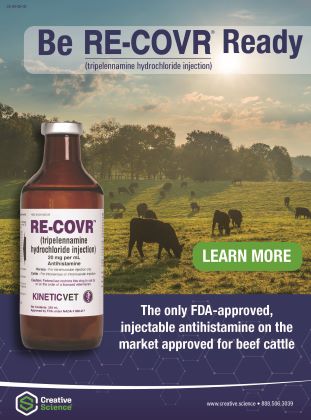Keepin’ It Cool

Keepin’ It Cool
By Maura Keller
Environmental factors can play a significant role in the health and wellbeing of dairy cattle. Particularly in warmer climates and during summer months, heat stress is one of the biggest concerns facing producers.
According to Scott Bascom, executive technical services manager at Phibro Animal Health, heat stress can be acute or chronic.
Acute involves the quick onset of heat stress conditions, is temporary, and cows recover. Cows experiencing acute heat stress will have a drop in feed intake and a drop in milk production but will then recover most, if not all, of the loss when the THI (temperature humidity index) falls below 68.
“This is the sort of heat stress we see in the Midwest in late spring/early summer where it will get hot for a couple of days but then the temperate is milder,” Bascom says.
Chronic heat stress involves long-term heat stress conditions, whereby the cow’s body temperature does not reduce enough during cooler parts of the day, leading to loss of DMI, production, and reproduction.
“This occurs when cows experience longer periods of time when the THI is above 68. Particularly if there is no heat abate strategy in place,” Bascome says. “This is the sort of heat stress cows experience in the hotter months of the summer.”
Dry cows are something producers need to pay attention as well. As Bascome explains, a dry cow that experiences heat stress during the dry period is more likely to calve early.
“University of Florida research shows these cows will make about 10 lbs. less milk per day in their next lactation compared to cows that are not heat stressed,” Bascome says. “More recent research from the University of Florida shows that calves carried by cows that are heat stressed in late gestation will not perform as well as calves carried by dams that were cooled and these calves will make less milk in their lifetime.”
According to Otto Boone, Eastern USA sales representative at Sun-North Systems, some of the biggest concerns with heat stress and dairy cattle are that a heat stressed cow will have a reduction in milk production, pregnancy rates and feed intake.
“Heat stress also leads to increased lameness, death rates and disease occurrence,” Boone says. “A heat stressed cow will also have shorter gestation periods and a lower immune function.”
Dan Fathke, sales and marketing manager at Rush-Co, further notes that producers really need to understand the issues that come along with heat stress. One of the biggest problems created by heat stress among dairy cows deals with the production of their milk.
“The University of Florida conducted a study that determine that dairy cows provided with shade produced 10-19% more milk than dairy cows without shade,” Fathke says. The industry continues to make improvements to help prevent heat stress related issues. These advancements include livestock ventilation curtains (often times operated with an electric switch for ease of operation), utilizing structures or buildings for shade, and tunnel and/or cross ventilation in barns, just to name a few. Rush-Co offers both Livestock Shade Systems as well as a Rush-Co Electric Livestock Curtains to help offset heat stress in livestock.
Well-Defined Solutions
Over time the dairy industry has learned a lot about cooling cows when it is hot outside. As Bascome points out, the use of fans and sprinklers has become common place. If a producer soaks a cow with water and then blows air over her, they can cause evaporative cool which is effective in dropping her core body temperature.
“However, not all barns adequately cool cows,” Bascome says. “In particular, there are a lot of dry cow barns that do not adequately cool these cows and we are learning that cooling dry cows has a significant impact on their performance and the performance of the calf they are carrying.”
Some of the advancements of the abatement and prevention of heat stress are include evaporative misting fans, high-volume/low-speed (HVLS) fans and soaking systems – all of which designed to cool the cow, keep her comfortable, healthy and producing. As Boone points out, the industry is seeing systems such as these evolve in ways that consume much less power, and significantly less water.
“These systems are now automated by temperature, humidity, and motion sensors,” Boone says. There are also additives in feed now to encourage cooling in cattle.”
Sun-North Systems offers several solutions when it comes preventing and managing heat stress. One of the company’s key systems, the Core Cool System, allows producers to be proactive against heat stress. Having evolved over the last decade from the Kow Kulher and Cool Blue System, this system is completely automated 24/7 throughout the year. The system monitors temperature-humidity index to stay efficient, keep cows cool and comfortable.
“There isn’t any water wasted with the Core Cool System as it will add artificial sweat to the cows in a holding area, bedding or feed bunk without increasing humidity in the barn,” Boone says.
Other solution to heat stress includes Sun-North Systems’ Altra Air Sailfin HVLS fans, which blanket a very large area, creating a comfort zone that can create an evaporative cooling effect of up to 7.2 degrees F. These fans are designed to create wind gusts of up to 6mph to keep cows cool and comfortable. As Boone points out, these fans have become increasingly popular in dairy barns as they improve air circulation and help maintain and encourage a comfortable environment.
In addition, the company’s Smart Soaker is a motion activated soaking system that can be mounted at the headrest of the bunk. The system activates when a cow moves underneath the sensor, activating the soaker system, saving water and time. This encourages dairy cattle to eat and be cooled.
“These systems are designed to cool hardworking dairy cattle effectively and efficiently, relieving heat stress, rewarding the producer with more milk, healthy herd and a terrific return on your investment,” Boone says.
Phibro Animal Health sells a product called OmniGen. In multiple research trials, the Philbro team has observed that cows fed OmniGen that experience heat stress have a lower core body temperature and lower respiration rates (a symptom of heat stress) than cows fed a placebo.
“In trials with heat stressed lactating cows, the cows fed OmniGen have improve dry matter intake, higher milk yield, and lower somatic cell counts than cows fed placebo treatments,” Bascome says. In a University of Florida trial conducted with heat stressed dry cows, the cows fed OmniGen had lower body temperature, lower respiration rates, and made more milk after calving than the cows that experienced heat stress and were fed a control diet.
Bascome says it’s important to remember that cows feel heat stress at lower temperatures and humidity than humans. So even if a person feels comfortable, cows may be experiencing heat stress.
“The first step to keeping cows comfortable is make sure she can be out of the sun when it is hot outside. Providing fans and sprinklers to cool cows is very important too,” Bascome says. The biggest mistake he sees made on farms is that dry cows are often overlooked when developing systems for keeping cows cool.
“Young calves also become heat stressed and farms should consider how they are keeping calves from becoming heat stressed by making sure they are housed in areas that have shade and adequate air movement to keep them cool and comfortable,” Bascome says.
To help producers manage a heat-stressed cow, Boone advises dairy farmers to provide an adequate barn equipped with optimized ventilation, access to clean water and implement a cooling system. Also, be proactive 12 months of the year, before the herd is compromised by heat stress.
“Implementing these practices will help dairy producers effectively manage heat stress whilst promoting animal welfare and maintain milk production,” says Boone, who points out that some of the future innovations surrounding heat stress management could include precision livestock farming.
“These systems utilize sensors, devices that gather data from the herd and individual cattle that monitor in real time,” Boone says. “There also could be genetic selection regarding herd genetics to develop dairy cattle breeds with more heat resistant genetics. Advances in genomic selection and engineering may fast track herds to more heat tolerant and better suited for their environments.”




